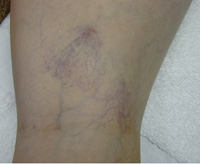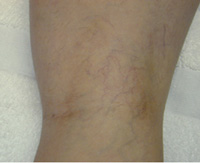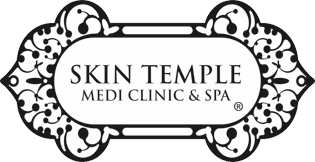Varicose veins are a common condition in the general population and especially affect women and those with a family history. In the earliest stages they may appear as ‘spider veins‘ which gradually enlarge with time to become palpable dilated varicose veins.
In the past there were few options other than invasive surgical procedures (ligation, stripping, avulsion) available to those with varicose veins, and only the worst affected patients were offered this option. Currently, sclerotherapy (micro-injections of solution into the problem veins) is the most used treatment for abnormal leg veins. However, recent technological advances have seen the development of the world’s first effective laser treatment of minor to moderate leg veins. Either treatment can usually be done as a walk-in, walk-out procedure following appropriate assessment. Sometimes it is necessary to assess the veins more closely with a duplex ultrasound prior to treatment. Larger veins are often referred for ultrasound guided sclerotherapy or endovenous laser ablation. Patients should avoid flying for 4 weeks prior to or following a treatment of sclerotherapy.
Before treatment:

Image: Supplied by Cutera
After treatment:

Image: Supplied by Cutera
How does blood circulate in the legs following treatment?
We have two sets of veins in our legs – deep and superficial. The deep veins are important, and hence deep venous thrombosis is a serious and potentially life threatening condition. These veins are left intact by the treatment. Treatment by either sclerotherapy or laser aims to treat the diseased and abnormally dilated superficial veins. The superficial veins are not necessary for normal circulation and that is why such a variety of treatments have been used in the past.
What is the solution used in sclerotherapy?
There are 3 solutions available for injection – hypertonic saline, aethoxysclerol and STS. They are all effective in the treatment of leg veins. Each solution has advantages and disadvantages. At Skin Temple we use aethoxysclerol (also known as polidocanol) because it is less likely to cause ulceration, scarring or allergic reactions.
Is it painful?
The needle used is the finest available and the amount of solution injected is very small. Despite this, the nature of the veins being injected means that sometimes they are smaller in diameter than the needle. This means that solution can sometimes leak out and cause a stinging sensation. In this situation and for those with a fear of needles it may be appropriate to use laser instead.
Are there any side effects?
Both spider veins and varicose veins treatments are extremely well tolerated and serious side effects such as deep venous thrombosis are very uncommon. Minor temporary side effects include bruising, pigmentation and matting. A full list of potential side effects will be outlined in a consent form prior to your treatment.
How many treatments are necessary?
This will largely depend on the severity and complexity of veins being treated. Sometimes it is necessary to perform a series of 4 treatments one month apart. Laser treatments are usually faster in effectiveness, but not always appropriate for every patient. Cost for standard microsclerotherapy (injection treatments) is $550 per session and is partially Medicare rebatable. Foam microsclerotherapy injections are $750 per session.
What happens after treatment?
Tape dressings are immediately applied and should be left intact for 1-2 days. Medical compression stockings are usually worn 24/7 for the first 4 days post treatment, then for another 10 days during the day only. Compression is very important in the overall outcome of the treatment.
For this reason, treatments are often done in the cooler months and avoided in summer. Skin Temple stocks a range of attractive compression stockings which are rebatable on ‘extras’ health insurance.
Exercise is important to reduce any post treatment minor swelling. If any of the treated veins become hard and tender they may need to have the trapped blood drained. This can be done with a follow up appointment at Skin Temple.
Want to read more about varicose vein treatment, including sclerotherapy? Then have a look at the American College of Phlebology website:www.phlebology.org
Why choose Skin Temple as your service provider?
Skin Temple is owned by an experienced female cosmetic physician, Dr Alicia Teska, with 22years of clinical cosmetic experience, including working with a cosmetic dermatologist. Dr Teska has also completed post-graduate studies in the field of Dermatology, gaining a Certificate in Dermatology from Monash University in 2005. All cosmetic injectable and laser procedures done at Skin Temple are performed only by trained, insured and experienced medical practitioners.
Request an appointment at Skin Temple: E-mail or Call 9867 2992
